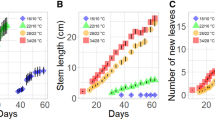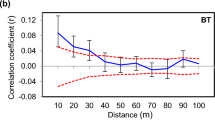Abstract
In 1923 Ohga1 first brought to general scientific attention the existence of a cache of viable seeds of East Indian lotus (Nelumbo nucifera Gaertn.), contained within an ancient lakebed deposit at Pulantien in southern Manchuria. From the geological and historical evidence available, Ohga suggested a possible age in excess of 400 years1,2. Libby3 radiocarbon dated some of Ohga's material at 1040±210 years BP. This evidence of great antiquity for viable seeds has been controversial4–6. The main hindrance to the resolution of the problem has been the paucity of available Pulantien seeds following the dissipation of Ohga's original collection7. Recently we have received four Pulantien seeds, three of which were viable, albeit lacking in vigour. The lipids of the unimbibed seeds were examined and found to be still highly polyunsaturated, suggesting that they had undergone little atmospheric autoxidation. Radiocarbon dating of one of the viable seeds suggested a probable age of about 466 years at the time of germination. This is the oldest viable seed for which an age has been directly determined.
This is a preview of subscription content, access via your institution
Access options
Subscribe to this journal
Receive 51 print issues and online access
$199.00 per year
only $3.90 per issue
Buy this article
- Purchase on Springer Link
- Instant access to full article PDF
Prices may be subject to local taxes which are calculated during checkout
Similar content being viewed by others
References
Ohga, I. Bot. Mag., Tokyo 37, 87–95 (1923).
Ohga, I. Bot. Mag., Tokyo 41, 1–6 (1927).
Libby, W. F. Science 114, 291–296 (1951).
Godwin, H. & Willis, E. H. New Phytol. 63, 410–412 (1964).
Wester, H. V. Hortscience 8, 371–377 (1973).
Justice, O. L. & Bass, L. N. Principles and Practices of Seed Storage (USDA Agriculture Handbook No. 506, Washington, D. C., 1978).
Chaney, R. W. Gdn. J.N.Y. bot. Gdn 1, 137–139 (1951).
Krishtofovich, A. N. Priroda, Mosk. Part 1, 76–78 (1953).
Ohga, I. Jap. J. Bot. 3, 1–20 (1926).
Ohga, I. Am. J. Bot. 13, 754–759 (1926).
Stuiver, M. Radiocarbon 24, 1–26 (1982).
Villiers, T. A. in Seed Ecology (ed. Heydecker, W.) 265–288 (Pennsylvania State University, University Park, 1973).
Howell, R. W. & Collins, F. I. Agron. J. 49, 593–597 (1957).
Harris, H. C., McWilliam, J. R. & Mason, W. K. Aust. J. agric. Res. 29, 1202–1212 (1978).
Anonymous Nature 149, 658 (1942).
Priestley, D. A., Galinat, W. C. & Leopold, A. C. Nature 292, 146–148 (1981).
Hallam, N. D. & Osborne, D. J. in Eighth International Congress on Electron Microscopy, Canberra, 1974, Vol. 2 (eds Sanders, J. V. & Goodchild, D. J.) 598–599 (Australian Academy of Science, Canberra, 1974).
Zhukova, G. Ya. & Yakovlev, M. S. Bot. Zhur. 61, 869–872 (1976).
Priestley, D. A., McBride, M. B., Galinat, W. C. & Leopold, A. C. Pl. Physiol. (Suppl). 67, 115 (1981).
Godwin, H. Nature 220, 708–709 (1968).
Lerman, J. C. & Cigliano, E. M. Nature 232, 568–570 (1971).
MacDougal, D. T. & Smith, G. M. Science 66, 456–457 (1927).
Fritts, H. C. Tree Rings and Climate (Academic, London, 1976).
Douce, R. & Lance, C. Physiol. Vég. 10, 181–198 (1972).
Author information
Authors and Affiliations
Rights and permissions
About this article
Cite this article
Priestley, D., Posthumus, M. Extreme longevity of lotus seeds from Pulantien. Nature 299, 148–149 (1982). https://doi.org/10.1038/299148a0
Received:
Accepted:
Issue Date:
DOI: https://doi.org/10.1038/299148a0
This article is cited by
-
Comparative population genomics reveals genetic divergence and selection in lotus, Nelumbo nucifera
BMC Genomics (2020)
-
Cloning a glutathione peroxidase gene from Nelumbo nucifera and enhanced salt tolerance by overexpressing in rice
Molecular Biology Reports (2014)
-
Thermal-Stable Proteins of Fruit of Long-Living Sacred Lotus Nelumbo nucifera Gaertn var. China Antique
Tropical Plant Biology (2013)
-
Centuries-Old Viable Fruit of Sacred Lotus Nelumbo nucifera Gaertn var. China Antique
Tropical Plant Biology (2013)
-
Changes in extreme high-temperature tolerance and activities of antioxidant enzymes of sacred lotus seeds
Science in China Series C: Life Sciences (2008)
Comments
By submitting a comment you agree to abide by our Terms and Community Guidelines. If you find something abusive or that does not comply with our terms or guidelines please flag it as inappropriate.



